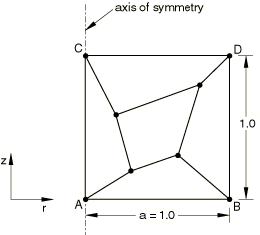Patch test for axisymmetric elements with twist | ||
| ||
ProductsAbaqus/Standard
Elements tested
CGAX3
CGAX3H
CGAX3HT
CGAX3T
CGAX4
CGAX4H
CGAX4HT
CGAX4R
CGAX4RH
CGAX4T
CGAX6
CGAX6H
CGAX6M
CGAX6MH
CGAX8
CGAX8H
CGAX8HT
CGAX8R
CGAX8RH
CGAX8RHT
CGAX8RT
CGAX8T
![]()
Problem description

Material:
Linear elastic, Young's modulus = 1.0 × 106, Poisson's ratio = 0.25, conductivity = 4.85 × 10−4.
Loading for Step 1
A twist of 0.01 per unit length applied to face CD.
1.0 × 10−2.
Loading for Step 2
Displacement boundary conditions applied to all exterior nodes: 10−3r, 10−3, 0.
Nonuniform body force: To maintain a constant shear stress 400 and preserve equilibrium, an equilibrating body force, BZNU, is defined in user subroutine DLOAD as BZNU = −400, where r is the radius of the integration point.
Loading for Step 3
Displacement boundary conditions applied to all exterior nodes: 10−2r, 10−2z, 0.
Loading for Step 4
Displacement boundary conditions applied to the deformed geometry of Step 2 at all exterior nodes: 10−3r, 10−3, 0.
Nonuniform body force (as described for Step 2): BZNU = −400.
Loading for Step 5
The displacement boundary conditions are the same as those applied in Step 3.
Temperatures are prescribed at every node along the boundary of the mesh. , where T is the temperature, and are arbitrary constants, and r, z denote spatial location.
Nonuniform distributed flux: To maintain a uniform heat flux, q, a distributed heat flux, BFNU, is defined in user subroutine DFLUX as BFNU = , where r is the radius of the integration point and k is the conductivity.
![]()
Reference solution
The analytical results for each step are presented below.
Step 1: perturbation
Shear stress, , where r is the radial distance from the axis of symmetry and G is the shear modulus.
Resultant moment, 2 = 6283.2.
Step 2: perturbation
2000.
400.
10−3.
10−3.
Step 3: geometrically nonlinear
19900.
0.
9.95 × 10−3.
0.
Step 4: perturbation
2000.
400.
1 × 10−3.
1 × 10−3.
Step 5: fully coupled thermal-stress
This step is applied only in tests of coupled temperature-displacement elements (CGAXxT).
Stresses and strains are the same as in Step 3. ; .
![]()
Results and discussion
The results agree well with the analytical solution for all elements.
Section output requests to the results (.fil) file and to the data (.dat) file are used in the input files with CGAX8RH elements to output accumulated quantities in different sections through the model.
![]()
Input files
- eca3gfp5.inp
-
CGAX3 elements.
- eca3gfp5.f
-
User subroutine DLOAD used in eca3gfp5.inp.
- eca3ghp5.inp
-
CGAX3H elements.
- eca3ghp5.f
-
User subroutine DLOAD used in eca3ghp5.inp.
- eca3hhp5.inp
-
CGAX3HT elements.
- eca3hhp5.f
- eca3hfp5.inp
-
CGAX3T elements.
- eca3hfp5.f
- eca4gfp5.inp
-
CGAX4 elements.
- eca4gfp5.f
-
User subroutine DLOAD used in eca4gfp5.inp.
- eca4ghp5.inp
-
CGAX4H elements.
- eca4ghp5.f
-
User subroutine DLOAD used in eca4ghp5.inp.
- eca4hhp5.inp
-
CGAX4HT elements.
- eca4hhp5.f
- eca4grp5.inp
-
CGAX4R elements.
- eca4grp5.f
-
User subroutine DLOAD used in eca4grp5.inp.
- eca4gyp5.inp
-
CGAX4RH elements.
- eca4gyp5.f
-
User subroutine DLOAD used in eca4gyp5.inp.
- eca4hfp5.inp
-
CGAX4T elements.
- eca4hfp5.f
- eca6gfp5.inp
-
CGAX6 elements.
- eca6gfp5.f
-
User subroutine DLOAD used in eca6gfp5.inp.
- eca6ghp5.inp
-
CGAX6H elements.
- eca6ghp5.f
-
User subroutine DLOAD used in eca6ghp5.inp.
- eca6gkp5.inp
-
CGAX6M elements.
- eca6gkp5.f
-
User subroutine DLOAD used in eca6gkp5.inp.
- eca6glp5.inp
-
CGAX6MH elements.
- eca6glp5.f
-
User subroutine DLOAD used in eca6glp5.inp.
- eca8gfp5.inp
-
CGAX8 elements.
- eca8gfp5.f
-
User subroutine DLOAD used in eca8gfp5.inp.
- eca8ghp5.inp
-
CGAX8H elements.
- eca8ghp5.f
-
User subroutine DLOAD used in eca8ghp5.inp.
- eca8hhp5.inp
-
CGAX8HT elements.
- eca8hhp5.f
- eca8grp5.inp
-
CGAX8R elements.
- eca8grp5.f
-
User subroutine DLOAD used in eca8grp5.inp.
- eca8gyp5.inp
-
CGAX8RH elements.
- eca8gyp5.f
-
User subroutine DLOAD used in eca8gyp5.inp.
- eca8hfp5.inp
-
CGAX8T elements.
- eca8hfp5.f